| Listing 1 - 10 of 46 | << page >> |
Sort by
|
Book
ISBN: 1280831774 9786610831777 1592597491 0896034704 Year: 1998 Publisher: Totowa, NJ : Humana Press : Imprint: Humana,
Abstract | Keywords | Export | Availability | Bookmark
 Loading...
Loading...Choose an application
- Reference Manager
- EndNote
- RefWorks (Direct export to RefWorks)
Michael Titheradge provides both the experienced researcher and the newcomer with time-tested techniques to cover all aspects of NO synthase and metabolism. Topics range from the cloning and expression of the different isoforms of NO synthase to the role of NO in DNA damage and apoptosis and include indirect and direct measurements of NO production, measurement on NO synthase mRNA both in situ and in vitro, and Western blotting and immunohistochemical localization of different isoforms of NO synthase. A variety of alternative techniques are described to enable researchers to set up an assay using either the simplest equipment or the most expensive EPR machines.
Biochemistry. --- Biochemistry, general. --- Biological chemistry --- Chemical composition of organisms --- Organisms --- Physiological chemistry --- Biology --- Chemistry --- Medical sciences --- Composition
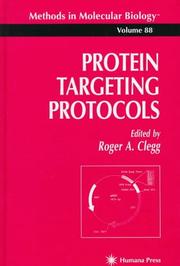
ISBN: 1280843055 9786610843053 1592595723 0896034879 089603450X Year: 1998 Publisher: Totowa, NJ : Humana Press : Imprint: Humana,
Abstract | Keywords | Export | Availability | Bookmark
 Loading...
Loading...Choose an application
- Reference Manager
- EndNote
- RefWorks (Direct export to RefWorks)
In Protein Targeting Protocols, master experimentalists describe, largely from the perspective of intracellular signaling, their best time-tested methods for detecting and analyzing the proteins and protein motifs involved in cellular targeting interactions. The techniques range from basic methods that reveal the existence of targeting interactions and characterize physicochemical properties to those for analyzing the more structurally elaborate systems involved in the movement of molecules between cellular compartments, with examples taken from nuclear transport, clathrin-coated vesicle traffic, and secretory sorting. The themes of targeting domains, particularly the SH-2, SH-3, and PH domains, and the principal targeting of lipid modifications-myristoylation, reversible palmitoylation, prenylation-are fully explored. Protein Targeting Protocols offers a valuable collection of both basic and state-of-the-art techniques suitable for use in all areas of molecular cell biology by researchers interested in defining and characterizing the wide variety of protein interactions underlying targeting mechanisms. Readers will find it serves well as a firm methodological foundation for laboratories newly entering this field and as an indispensable reference work for those already well-established in it.
Biochemistry. --- Biochemistry, general. --- Biological chemistry --- Chemical composition of organisms --- Organisms --- Physiological chemistry --- Biology --- Chemistry --- Medical sciences --- Composition --- Protein binding --- Research --- Laboratory manuals.
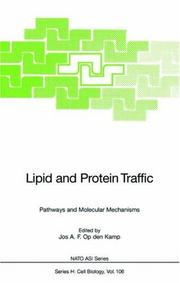
ISBN: 3540641157 3642514650 3642514634 Year: 1998 Volume: 106
Abstract | Keywords | Export | Availability | Bookmark
 Loading...
Loading...Choose an application
- Reference Manager
- EndNote
- RefWorks (Direct export to RefWorks)
The meeting on "Molecular Mechanisms of Lipid and Protein Traffic", sponsored by NATO Scientific Affairs Division as an Advanced Study Institute and by the Federation of European Biochemical Societies as a Lecture Course was held in Cargese, France, in June 1997. The program included introductory lectures, specialized up-to-date contributions, poster sessions, tutorials and workshops. Emphasis was laid on the new developments in the field of membrane dynamics, in particular on the insertion and translocation of proteins; on intracellular protein, lipid and membrane traffic and sorting and on the mutual interactions between the various events occurring during membrane biogenesis. Mitochondrial biogenesis, chloroplast assembly and the insertion of proteins into peroxisomes were highlighted. Much progress in these research areas has been made in recent years and the ASI provided an excellent opportunity to illustrate this progress in comparison with previous meetings on a similar topic. Not only graduate students and postdocs took advantage from this program but also experienced scientists were given the opportunity to obtain a complete overview of recent progress and the remodeling of ideas and concepts.
Molecular biology --- Membrane proteins --- Physiological transport --- Congresses --- Membrane lipids --- Biochemistry. --- Cell biology. --- Biochemistry, general. --- Cell Biology. --- Cell biology --- Cellular biology --- Biology --- Cells --- Biological chemistry --- Chemical composition of organisms --- Organisms --- Physiological chemistry --- Chemistry --- Medical sciences --- Composition --- Membranes (Biology) --- Lipids --- Proteins
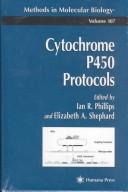
ISBN: 0896035190 9786610836918 1280836911 1592595804 Year: 1998 Publisher: Totowa, NJ : Humana Press : Imprint: Humana,
Abstract | Keywords | Export | Availability | Bookmark
 Loading...
Loading...Choose an application
- Reference Manager
- EndNote
- RefWorks (Direct export to RefWorks)
In Cytochrome P450 Protocols, Ian Phillips and Elizabeth Shephard assemble a comprehensive collection of cutting-edge techniques for the investigation of cytochromes P450. Described in detail by hands-on experimentalists for easy reproducibility, these methods include spectral analysis, purification and enzymatic assays, expression in heterologous systems, and the production and use of antibodies, as well as methods for quantification of gene expression, transfection of hepatocytes, and for the investigation of DNA-protein interactions and genetic polymorphisms. In addition, because of the growing importance of in vitro systems in pharmacological toxicology, the book contains techniques for the culture of rodent and human hepatocytes and human epidermis. Cytochrome P450 induction as a biomarker for environmental pollution and the generation of mice with targeted gene disruptions complete this exhaustive collection of core techniques. Cytochrome P450 Protocols includes in one volume both state-of-the-art and classic methods that have not been superseded but remain extremely useful. The collection provides both novice and experienced researchers across many fields-toxicology, pharmacology, environmental biology, biochemistry, and molecular biology-all the tools needed to elucidate the crucial biological role played by cytochromes P450 in the metabolism of therapeutic drugs, chemical carcinogens, and environmental pollutants.
Cytochrome P-450 -- Laboratory manuals. --- Cytochrome P-450 --- Animal Biochemistry --- Human Anatomy & Physiology --- Health & Biological Sciences --- Laboratory manuals --- Laboratory manuals. --- Cytochromes --- Metalloenzymes --- Monooxygenases --- Biochemistry. --- Biochemistry, general. --- Biological chemistry --- Chemical composition of organisms --- Organisms --- Physiological chemistry --- Biology --- Chemistry --- Medical sciences --- Composition
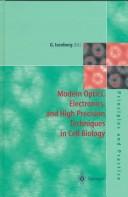
ISBN: 3540626735 3642803725 3642803709 Year: 1998 Publisher: Berlin Springer
Abstract | Keywords | Export | Availability | Bookmark
 Loading...
Loading...Choose an application
- Reference Manager
- EndNote
- RefWorks (Direct export to RefWorks)
In spite of tremendous scientific progress over the past years, cell biologists do not yet understand the fundamental processes that determine the life cy cle of a cell. Such are: cell movement and cell spreading, cell division, cell communication, cell signaling, cell regeneration and cell death. Biochemistry has enabled us to recognize and to isolate an overwhelming number of new proteins. In vitro assays and the reinjection of proteins into cells and tissues have provided insights into molecular functions and cellular mechanisms. The renaissance of the genetic approach by applying restriction enzymes and vectors, PCR and antisense technology has enabled us to overexpress certain cellular products, to make altered constructs of cell components or to create "knock-out" mutants that entirely lack the factor of interest. Amazingly en ough, all these molecular toys have led to a stream of information but not, in a comparable degree, to a better understanding. Has the puzzle become too complex to get solved; or are the windows too small that we are looking through? As an attempt to answer both questions, the aim of the present mono graph Modern Optics, Electronics and High Precision Techniques in Cell Biol ogy is first to provide cell and molecular biologists with a whole new scope of easily applicable techniques including brand-new optical, biophysical, physicochemical and biosensoric devices. Secondly, these newly developed techniques allow us to look at cells and biological systems as a whole.
Biosensors. --- Cytology --- Microscopy. --- Molecular biology --- Basic Sciences. Biology --- Technique. --- Cellular Biology. --- Cell biology. --- Biochemistry. --- Cell Biology. --- Biochemistry, general. --- Biological chemistry --- Chemical composition of organisms --- Organisms --- Physiological chemistry --- Biology --- Chemistry --- Medical sciences --- Cell biology --- Cellular biology --- Cells --- Composition
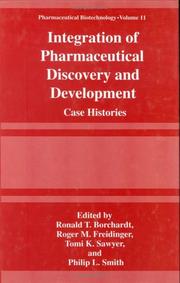
ISBN: 128020821X 9786610208210 0306473844 0306457431 Year: 1998 Publisher: New York, NY : Springer US : Imprint: Springer,
Abstract | Keywords | Export | Availability | Bookmark
 Loading...
Loading...Choose an application
- Reference Manager
- EndNote
- RefWorks (Direct export to RefWorks)
In the late 1980s, it became painfully evident to the pharmaceutical industry that the old paradigm of drug discovery, which involved highly segmented drug - sign and development activities, would not produce an acceptable success rate in the future. Therefore, in the early 1990s a paradigm shift occurred in which drug design and development activities became more highly integrated. This new str- egy required medicinal chemists to design drug candidates with structural f- tures that optimized pharmacological (e. g. , high affinity and specificity for the target receptor), pharmaceutical (e. g. , solubility and chemical stability), bioph- maceutical (e. g. , cell membrane permeability), and metabolic/pharmacokinetic (e. g. , metabolic stability, clearance, and protein binding) properties. Successful implementation of this strategy requires a multidisciplinary team effort, incl- ing scientists from drug design (e. g. , medicinal chemists, cell biologists, en- mologists, pharmacologists) and drug development (e. g. , analytical chemists, pharmaceutical scientists, physiologists, and molecular biologists representing the disciplines of pharmaceutics, biopharmaceutics, and pharmacokinetics/drug metabolism). With this new, highly integrated approach to drug design now widely utilized by the pharmaceutical industry, the editors of this book have provided the sci- tific community with case histories to illustrate the nature of the interdisciplinary interactions necessary to successfully implement this new approach to drug d- covery. In the first chapter, Ralph Hirschmann provides a historical perspective of why this paradigm shift in drug discovery has occurred.
Drug development. --- Drugs --- Design. --- Testing. --- Animal physiology. --- Biochemistry. --- Animal Physiology. --- Biochemistry, general. --- Biological chemistry --- Chemical composition of organisms --- Organisms --- Physiological chemistry --- Biology --- Chemistry --- Medical sciences --- Animal physiology --- Animals --- Anatomy --- Composition --- Physiology
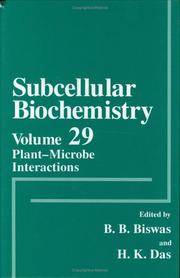
ISBN: 0306456788 1489917098 1489917071 Year: 1998 Volume: 29 Publisher: New York ; London Plenum press
Abstract | Keywords | Export | Availability | Bookmark
 Loading...
Loading...Choose an application
- Reference Manager
- EndNote
- RefWorks (Direct export to RefWorks)
Recent years have seen tremendous progress in unraveling the molecular basis of different plant-microbe interactions. Knowledge has accumulated on the mecha nisms of the microbial infection of plants, which can lead to either disease or resistance. The mechanisms developed by plants to interact with microbes, whether viruses, bacteria, or fungi, involve events that can lead to symbiotic association or to disease or tumor formation. Cell death caused by pathogen infection has been of great interest for many years because of its association with plant resistance. There appear to be two types of plant cell death associated with pathogen infection, a rapid hypersensitive cell death localized at the site of infection during an incompatible interaction between a resistant plant and an avirulent pathogen, and a slow, normosensitive plant cell death that spreads beyond the site of infection during some compatible interactions involving a susceptible plant and a virulent, necrogenic pathogen. Plants possess a number of defense mechanisms against infection, such as (i) production of phytoalexin, (ii) formation of hydrolases, (iii) accumulation of hydroxyproline-rich glycoprotein and lignin deposition, (iv) production of pathogen-related proteins, (v) produc tion of oligosaccharides, jasmonic acid, and various other phenolic substances, and (vi) production of toxin-metabolizing enzymes. Based on these observations, insertion of a single suitable gene in a particular plant has yielded promising results in imparting resistance against specific infection or disease. It appears that a signal received after microbe infection triggers different signal transduction pathways.
Histology. Cytology --- Phytopathology. Phytoparasitology --- Plant-microbe relaties --- Plant-microbe relationships --- Relations plante-microbe --- Biochemistry. --- Plant science. --- Botany. --- Biochemistry, general. --- Plant Sciences. --- Botanical science --- Phytobiology --- Phytography --- Phytology --- Plant biology --- Plant science --- Biology --- Natural history --- Plants --- Biological chemistry --- Chemical composition of organisms --- Organisms --- Physiological chemistry --- Chemistry --- Medical sciences --- Composition --- Floristic botany --- Symbiosis. --- Plant-microbe relationships. --- Microbiology. --- Plant-microbe interactions --- Consortism --- Symbiogenesis --- Microbiology --- Bacteriology
Book
ISBN: 3540634290 3642719430 3642719414 9783540634294 Year: 1998 Volume: 227 Publisher: Berlin ; Milan ; Paris Springer
Abstract | Keywords | Export | Availability | Bookmark
 Loading...
Loading...Choose an application
- Reference Manager
- EndNote
- RefWorks (Direct export to RefWorks)
More than 10 years ago, the discovery of cyclin-dependent ki nases (Cdks) ushered in a new era in the understanding of cell proliferation and its control. Not only were both of the known cell cycle transitions, from G 1 to S phase and G2 to M phase, found to be dependent on these protein kinases, but the reg ulatory assumption intrinsic to cyclin-dependent kinases, a stable inactive catalytic subunit (the Cdk) and an unstable requisite positive regulatory activating subunit (the cyclin), led to a simple model for cell cycle control. Modulation of cyclin accumulation, and thereby Cdk activation, was proposed to be the overarching principle governing the passage through cell cycle phases. An other reality to emerge from the discovery of Cdks was the ex ceptional degree of evolutionary conservation maintained in the machinery and organization of proliferation control. Not only were Cdks shown to be structurally conserved between yeast and man, but mammalian Cdks could substitute functionally for the endogenous enzymes in a yeast cell. The problem of cell cycle control was thought to have been virtually solved. The ensuing years have provided a much more complex view of cell cycle control and the role and regulation of Cdks. The uncritical enthusiasm with which many of the ideas were em braced has required tempering. For example, although Cdks appear to be highly conserved phylogenetically, cyclins are much less so.
Cancer--Pathogenesis --- Carcinogenese --- Carcinogenesis --- Carcinogénèse --- Cell proliferation --- Cell renewal --- Cellen--Proliferatie --- Cellular proliferation --- Kanker--Ontstaan --- Oncogenesis --- Pathogenesis of cancer --- Proliferation cellulaire --- Tumorigenesis --- Cyclin kinase --- Inhibitors --- Immunology. --- Cell biology. --- Cancer research. --- Biochemistry. --- Cell Biology. --- Cancer Research. --- Biochemistry, general. --- Biological chemistry --- Chemical composition of organisms --- Organisms --- Physiological chemistry --- Biology --- Chemistry --- Medical sciences --- Cancer research --- Cell biology --- Cellular biology --- Cells --- Immunobiology --- Life sciences --- Serology --- Composition
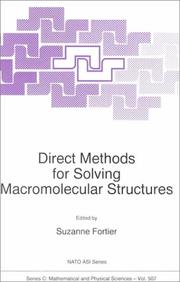
ISBN: 0792349490 9048149940 9401590931 9780792349495 Year: 1998 Volume: 507
Abstract | Keywords | Export | Availability | Bookmark
 Loading...
Loading...Choose an application
- Reference Manager
- EndNote
- RefWorks (Direct export to RefWorks)
This book of the proceedings of the 1997 NATO Advanced Study Institute (ASI) on Direct Methods for Solving Macromolecular Structures was assembled from the lecturers' contributions and represents a comprehensive and in-depth overview of crystallographic structure determination methods for macromolecules. While having a focus based on the direct methods, the Institute adopted an inclusive and broad perspective. Thus, both direct and experimental phasing techniques are presented in this book, highlighting their complementarities and synergies. As weil, methodologies spanning the full crystallographic image reconstruction process - from low resolution envelope definition to high resolution atomic refinement- are discussed. The first part of the book introduces the array of tools currently used in structure determination, whether originating from a mathematical, computational or experimental framework. This section of the book displays the variety and ingenuity of old and new phasing approaches developed to solve increasingly complex structures. Some of the contributions focus on recent developments and/or implementations that have given older approaches a new life. A case in point is the re-implementation of Buerger's superposition approach, which is now solving protein structures. Another beautiful example is found in the introduction to the traditional multiple isomorphous replacement approach where new techniques, such as site-directed mutagenesis and the use of inert gases in the preparation of heavy atom derivatives, are described. Equally impressive are the presentations of newer approaches, which take advantage of advances on the experimental front (e. g.
Macromolecules --- Crystallography --- Structure --- Congresses --- Crystallography. --- Biochemistry. --- Physical chemistry. --- Crystallography and Scattering Methods. --- Biochemistry, general. --- Physical Chemistry. --- Chemistry, Theoretical --- Physical chemistry --- Theoretical chemistry --- Chemistry --- Biological chemistry --- Chemical composition of organisms --- Organisms --- Physiological chemistry --- Biology --- Medical sciences --- Leptology --- Physical sciences --- Mineralogy --- Composition --- Molecules --- Supramolecular chemistry --- Macromolecules - Structure - Congresses --- Crystallography - Congresses
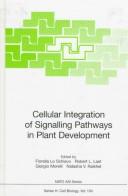
ISBN: 3540640142 3642721192 3642721176 9783540640141 Year: 1998 Volume: 104
Abstract | Keywords | Export | Availability | Bookmark
 Loading...
Loading...Choose an application
- Reference Manager
- EndNote
- RefWorks (Direct export to RefWorks)
In the last few years there have been tremendous advances in the understanding of signals and signalling pathways that operate at the cellular level and lead to developmental processes. In 27 chapters, this volume investigates the cellular and molecular basis of plant development. It highlights the most recent progress on signals, machinery, and pathways in the plant cell. Emphasis is placed on integrating these studies with those on cell division, cell plate formation, and other aspects of plant development, in order to elucidate the intricate relationships between them.
Plant cellular signal transduction --- Plants --- Congresses --- Development --- Congresses. --- Cell biology. --- Biochemistry. --- Plant science. --- Botany. --- Cell Biology. --- Biochemistry, general. --- Plant Sciences. --- Botanical science --- Phytobiology --- Phytography --- Phytology --- Plant biology --- Plant science --- Biology --- Natural history --- Biological chemistry --- Chemical composition of organisms --- Organisms --- Physiological chemistry --- Chemistry --- Medical sciences --- Cell biology --- Cellular biology --- Cells --- Composition --- Floristic botany --- Plant cellular signal transduction - Congresses --- Plants - Development - Congresses
| Listing 1 - 10 of 46 | << page >> |
Sort by
|

 Search
Search Feedback
Feedback About
About Help
Help News
News